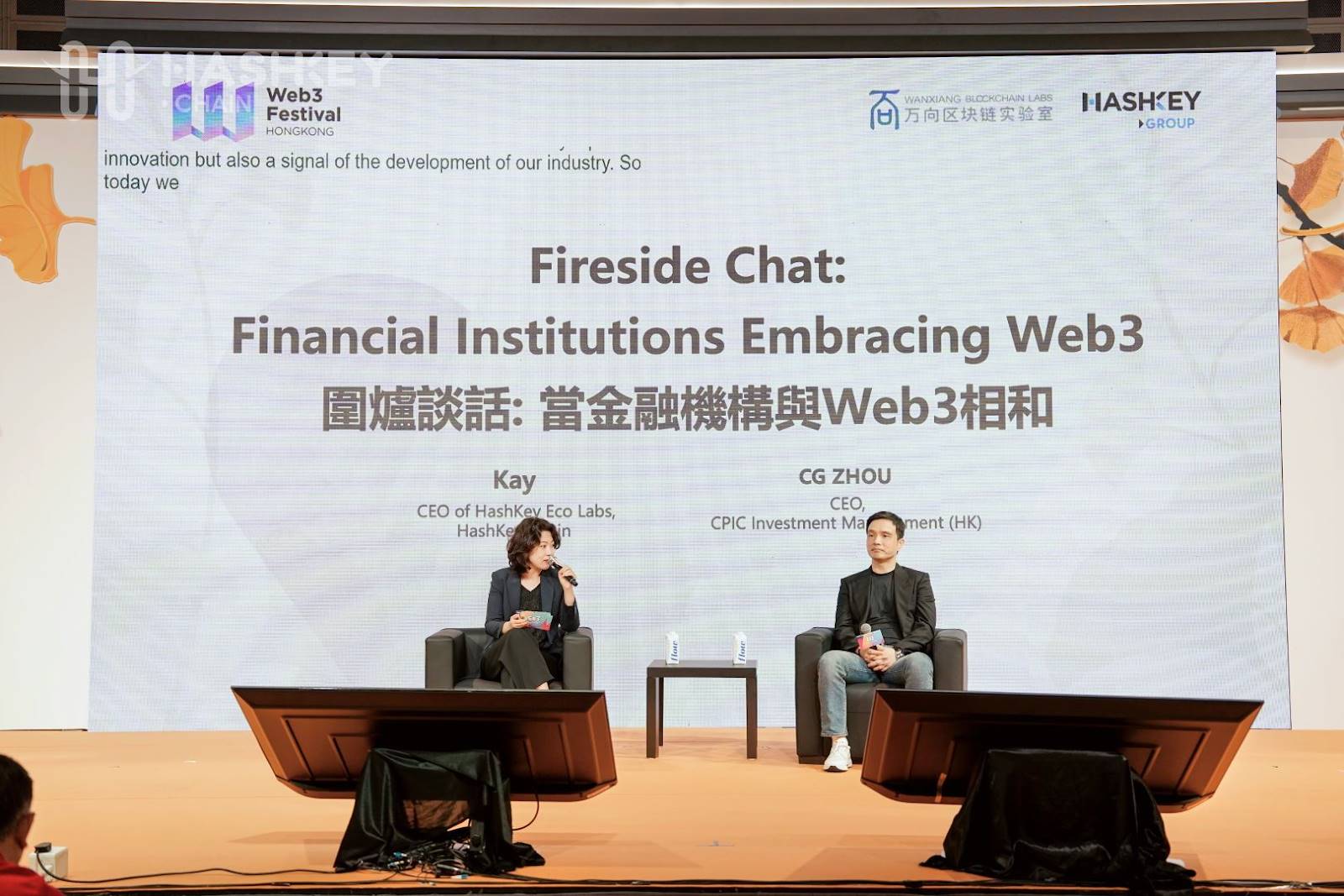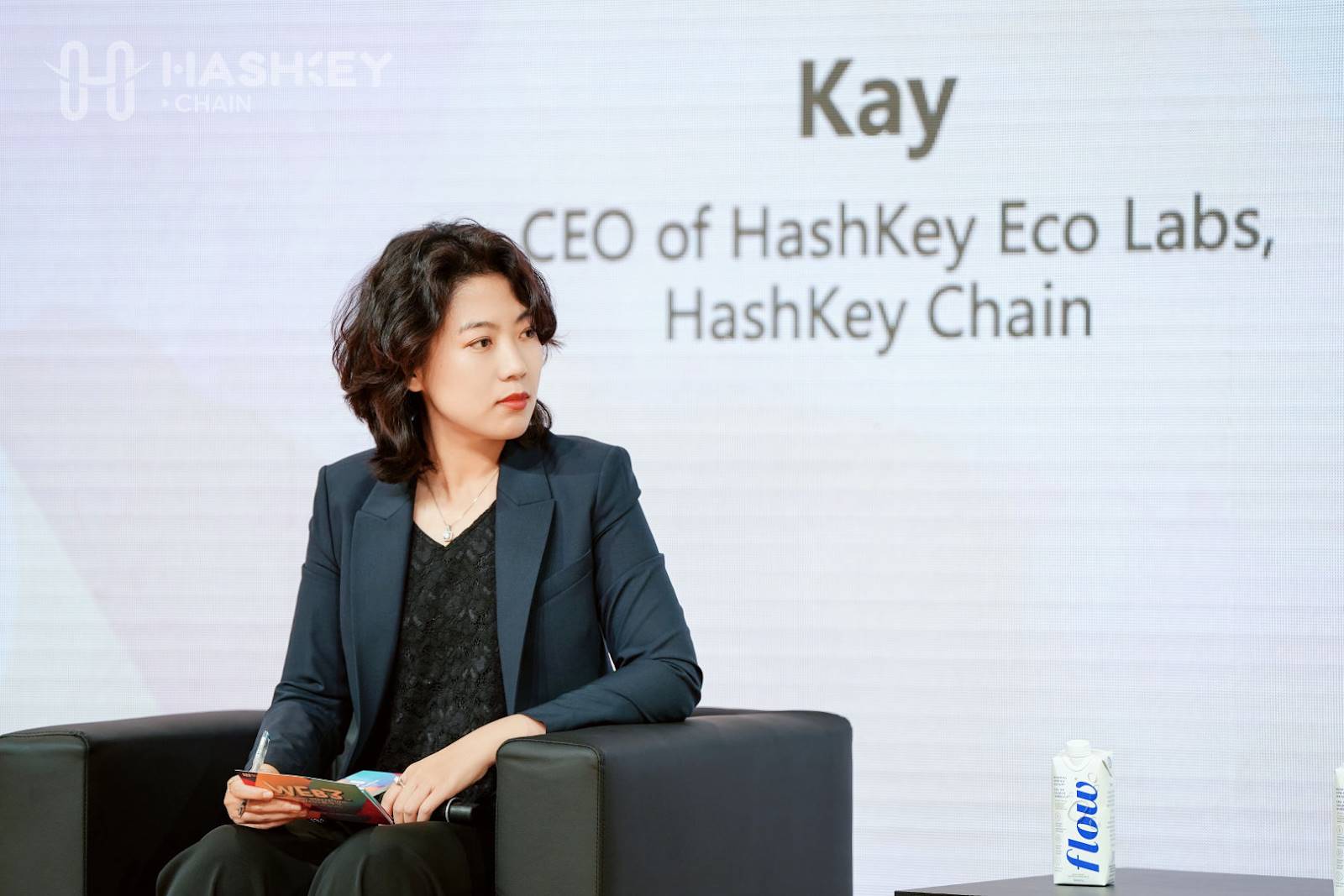The entry of institutions into Web3 is not an overnight process; it requires finding a feasible path within the existing regulatory framework and balancing innovation with stability.
On April 6, at the WEB3 Festival, a session themed "Fireside Chat: When Financial Institutions Harmonize with Web3" attracted significant attention.
HashKey Eco Labs CEO Kay and Mr. CG, CEO of China Pacific Insurance Investment Management (Hong Kong), engaged in an in-depth discussion on blockchain technology, digital assets, and the future trends of RWA. Below are the highlights of their conversation:

Kay: Just now, we saw that this panel is one of the most popular segments of the entire event, with a full house, reflecting the high level of interest from both Web2 and Web3 practitioners in the RWA sector. The advancement of RWA cannot be separated from the participation and support of traditional financial institutions, nor from the integration of Web3 technology and concepts. Therefore, today we will delve into the theme of "The Integration of Web3 and Traditional Finance."
I am Kay, and I am honored to host today’s panel. We also have a heavyweight guest—Mr. CG, the founder and CEO of China Pacific Insurance Investment Management (Hong Kong). Welcome, please greet everyone so that more friends can get to know you.
CG: Thank you, Kay. Good afternoon, everyone. I am CG from Pacific Asset Management Hong Kong. I just took a walk around the venue and found that our event is indeed very lively; it can be said to be the most bustling one today. Thank you all for your attention and support.
- Opportunities and Intentions for Traditional Financial Institutions Entering Web3
Kay: In the past two years, blockchain technology has gradually moved from proof of concept to practical application, especially in the traditional financial sector, where more and more institutions are beginning to focus on asset tokenization, transparency, and efficient circulation. Pacific Hong Kong has taken an important step in this field by launching a tokenized US dollar money market fund—CPIC Estable MMF, using HashKey Chain as the on-chain infrastructure, which achieved a subscription amount of $100 million on its first day. This is not only an innovation in products but also signals the development of the industry. The question we are exploring today is: Why are institutions like Pacific, which have long been entrenched in the financial market, starting to pay attention to Web3? From the institutional perspective, what is the value of blockchain? What opportunities are worth exploring in the future?
As a Web3 practitioner, I would like to ask Mr. CG: Web3 was initially driven by a group of tech geeks and native players, but in recent years, the attention from traditional institutions has rapidly increased. Blockchain technology has transformed from a "geek toy" to an important technological infrastructure in the financial sector in less than a decade. As the leader of Pacific Hong Kong, how do you view this rapid transformation?
CG: From our institution's perspective, whether it is RWA or asset tokenization, it is a natural progression. We obtained the relevant licenses from the Hong Kong Securities and Futures Commission two years ago, and during this period, we have also issued four Crypto Funds. In fact, we started considering entering the direction of Tokenization or RWA over a year ago. It is worth mentioning that at that time, the term "RWA" had not yet become popular, and it might not have been widely used. For us, we are already managers of RWA, managing traditional financial assets such as stocks and bonds, rather than purely Crypto. Therefore, entering this field feels very natural for us.
When we began preparing RWA-related projects a year ago, we did not anticipate that many discussions at today’s Web3 Festival would revolve around RWA, nor did we expect this topic to be so well-received. Our initial thought was quite simple—the revenue model on-chain seems limited, mainly reflected in two aspects: transaction fees and lending interest. Besides that, many "yields" are actually based on the issuance of air tokens, which we are cautious about.
Therefore, from our perspective, we manage real-world assets that have stable and sustainable returns. We hope to tokenize these assets, put them on-chain, and provide asset products with real underlying revenue support to the Web3 ecosystem. This not only fills a market gap but also aims to change some of the biases and misunderstandings that the traditional financial sector has towards the Web3 world—they often feel that Web3 is "running in place" and lacks substantial support. We hope that through such practices, we can bring a more solid value foundation to the Web3 world and promote healthier development in this industry.

- Real Challenges in the Transformation of Traditional Institutions
Kay: Thank you, Mr. CG, for your insightful sharing, which deepens our understanding of an important topic: all seemingly great innovations actually stem from the ordinary accumulation over time. It is precisely based on a deep understanding of the financial industry and long-term accumulation that Pacific Hong Kong can establish a benchmark case in the Web3 field.
But I would like to raise a more specific question. We often liken the entry of traditional institutions into Web3 to "turning an elephant," as their size and complex processes present numerous real-world obstacles. The entry of institutional investors also means higher demands for security, compliance, and liquidity. Mr. CG, what real issues has Pacific Hong Kong encountered in exploring Web3? How have you adapted, resolved these issues step by step, and ultimately promoted the successful implementation of projects?
CG: This is a great question. When we obtained the SFC license from the Hong Kong Securities and Futures Commission two years ago and began preparing Crypto funds, we examined many similar funds on the market. We found that many funds had very weak internal controls, and some even lacked middle and back offices, which is unacceptable in the traditional financial system.
So, when many friends in the Web3 circle asked us "What are you here to do?" and "What can you bring?", my answer was very straightforward: we hope to bring the mature experience and standardized processes accumulated by traditional finance over the decades into Web3 asset management. Especially in terms of security, risk control, and compliance, we aim to establish a standard that can benchmark traditional funds.
Of course, we must also face reality. The current Web3 infrastructure is still far from mature, with the most obvious issue being custody. In traditional asset management, asset custody is very mature and secure, but in the Web3 field, many aspects, from custody to banking interfaces to fund administration services, are still in exploration.
Currently, we can achieve about 70%-80% of the standards of traditional funds, which is already a relatively high level of regulation in the industry. We also maintain honesty and transparency and believe that as the infrastructure continues to improve, we will have the opportunity to further enhance this ratio and truly achieve deep integration between traditional finance and Web3.
- Choosing the Practical Path for Asset Tokenization
Kay: Thank you, Mr. CG, for your very incisive sharing, which also answers a long-standing question for us: why many traditional asset management institutions have not made as rapid progress as expected in exploring on-chain solutions. In fact, many Web3 infrastructures currently cannot meet the high standards that traditional finance has already established.
This is precisely where HashKey's value as a compliant licensed institution in Hong Kong lies. We originated in Hong Kong and currently possess comprehensive compliance service capabilities in various fields such as public chains, exchanges, and custody, enabling us to provide complete infrastructure support for asset tokenization. We also look forward to more collaboration with Pacific Asset Management in the future.
RWA is one of the hottest topics in the Web3 field, especially in the past two years, when discussions about RWA often focus on asset types like bonds and real estate. However, the asset pool of insurance asset management is far more than that. In your view, which assets are most suitable for initial tokenization? Will we have the opportunity to see Pacific move "anchor assets" like insurance policies and infrastructure investments onto the chain in the future?
CG: This is a key question. We have conducted extensive internal discussions, and at this stage, we are only focusing on the tokenization of financial assets, not physical assets.
Why? Because the essence of tokenization is to issue a token on-chain that represents a real-world asset, and ensuring a strong connection between the token and the underlying asset is the most fundamental and challenging aspect. Take physical assets as an example, such as Moutai liquor—how do you verify that this bottle of Moutai actually exists? If it is consumed, damaged, or counterfeit, the trust bond between the token and the asset is broken.
In contrast, financial assets—especially standardized assets like fund shares—can clearly ensure the binding relationship between the token and the underlying asset in legal terms, and they are easier to regulate and custody. This is why we currently only choose financial assets as the target for RWA.
Another core question is: why should we pursue tokenization? This is not a decision that can be driven by "trends," but must have clear financial logic and practical significance. We believe the core value of RWA has two aspects:
First, it lowers the threshold and expands access for investors. Previously, certain high-threshold asset classes could only be participated in by institutions, but through tokenization, ordinary investors can also hold shares of these assets.
Second, it enhances efficiency, including the convenience of transactions and cost reduction. If tokenization does not bring significant improvements in liquidity, efficiency, or security, it loses its meaning. For example, tokenizing a bottle of Moutai does not bring any additional benefits; instead, it adds complexity and cost.
Similarly, for real estate, although there are already mature paths for securitization through REITs, whether it really needs further tokenization requires specific analysis of the underlying value logic. If it does not bring new financial advantages and is merely for the sake of "going on-chain," I believe it is unsustainable.
In summary, the first thing to address in RWA is "why do it," followed by "what to do" and "how to do it." Only tokenization that brings real value is worth promoting.

- Advice for Traditional Financial Institutions Entering the Market
Kay: This is indeed a very valuable sharing for every practitioner present. Especially for those exploring participation in issuance through RWA, Mr. CG's views remind us to think about the most core essential questions. Based on this, I would like to ask Mr. CG, do you have any practical experiences to share with traditional financial institutions that are still observing? For those institutions that are still hesitating about entering the market, what foundational capabilities do you think they need to possess? What suggestions or experiences can you share regarding organizational structure, talent reserves, or technology selection?
CG: First of all, I believe that RWA is indeed a trend-driven and highly certain track. As a traditional finance practitioner, we have seen many "hot spots" in the Web3 field over the past few years—whether in technology, ecology, or application levels, there have indeed been many projects that came quickly and left just as fast, making it difficult for us to assess their sustainability. However, among all Web3 directions, RWA is the closest to traditional financial logic and the most likely path to achieve scalable implementation. It connects real-world assets with on-chain infrastructure, a connection that we can understand and evaluate.
Therefore, for traditional financial institutions, RWA is a direction worth investing in. I recommend establishing dedicated innovation teams or Web3 business units within the organizational structure; in terms of human resources, reserve composite talents who understand both finance and on-chain mechanisms; and in technology, it is not necessary to build everything in-house, but to choose trustworthy, secure, and compliant cooperative platforms—such as HashKey, which is also very willing to provide support and cooperation in this regard.
We look forward to more traditional institutions joining in to jointly promote the establishment and maturity of the RWA ecosystem.
- Conclusion
Kay: The entry of institutions into Web3 is not an overnight process; it requires finding a feasible path within the existing regulatory framework and balancing innovation with stability. The collaboration between Pacific and HashKey Chain is just the beginning. I believe that in the near future, we will see more traditional financial assets achieving more efficient circulation through blockchain, and more institutions truly entering Web3, allowing this industry to transition from exploration to true maturity. Today's dialogue reminds me of a saying: "History does not repeat itself, but it often rhymes." We have seen the harmony between traditional finance and Web3 in the practices of Pacific Hong Kong, a combination that carries both compliance-minded thinking and the courage to innovate.
Thank you, Mr. CG, for such a sincere and warm sharing, and thanks to everyone present. We look forward to seeing more Chinese institutions in the wave of on-chain finance in the future. See you next time!
免责声明:本文章仅代表作者个人观点,不代表本平台的立场和观点。本文章仅供信息分享,不构成对任何人的任何投资建议。用户与作者之间的任何争议,与本平台无关。如网页中刊载的文章或图片涉及侵权,请提供相关的权利证明和身份证明发送邮件到support@aicoin.com,本平台相关工作人员将会进行核查。




